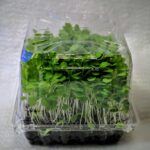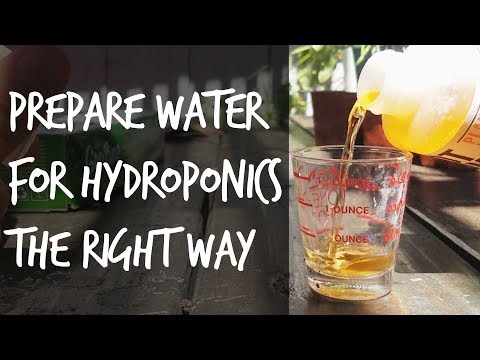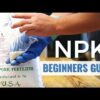How to Prepare Water for Hydroponics – pH, TDS, and PPM
If you’ve ever wondered how to prepare water properly for use in hydroponics in regards to pH, TDS, and ppm, this is the video for you. When preparing your water for hydroponics, always mix in your nutrients BEFORE you check and fix pH. You will see why in the video as the nutrients will affect your pH. Many people new to hydroponic growing get confused by the variety of terms and acronyms that are used to discuss nutrient strength and the various means used to calculate them so I will review this as well.
One big question growers ask is “Why are my plants suffering even though I used all the right nutrients, feeding cycles, my grow lights are good, and I adjusted temperatures & conditions to their absolute best?” That’s because their pH and PPM levels are off, making it difficult for their plants to eat. pH refers to the potential of Hydrogen ions in your water, which will determine if your water is too acidic or has too much alkaline in it. PPM (parts per million) refers to the concentration of minerals and soluble matter in your watering solution. Correct pH and PPM levels are the backbone of any grow room and will be the difference between a healthy harvest and a huge waste of time and money.
How to Prepare Water for Hydroponics – pH Levels
Simply put: the right pH level will create an environment where your plants can absorb nutrients quickly and easily, leading to a better harvest.
To prepare your water for hydroponics, nutrient-rich water is filled with elements that are helpful to your plants. However, if those elements can be broken down properly those same elements can harm your plants.pH levels are important to understand because the right level will determine the quality of helpful bacteria in your water that help break down elements, helping the metabolic rate of your plants. How? In two ways:
- When pH levels are too low (pH level of around 5 or lower), heavy metals like iron and aluminum change and can become toxic to your plants
- If the pH level is too high (pH level of around 6.5 or higher) elements like calcium and phosphorus can’t be broken down completely, which will hinder the growth of your plants
This change in properties is due to how acidic your water is or is not. You’ll want your plants’ nutrients to be a little acidic otherwise they can’t break down, but too much acidity and your nutrients can become toxic. So Remember pH too low= toxic to your plants, too high= growth decrease. That’s why you want to have the perfect level of acidity in your water, which will be around 5.5-6.0
So Remember pH too low= toxic to your plants, too high= growth decrease. That’s why you want to have the perfect level of acidity in your water, which will be around 5.5-6.0
Definitions:
EC – Electrical conductivity
TDS – Total Dissolved Solids
PPM or Parts Per Million – A measure of TDS
TDS or PPM Meter – An electronic device used to test EC in a nutrient solution
How the meter works:
Most nutrients in a hydroponic fertilizer dissolve into ions that your plants can absorb and use to grow. Consequently, the ions in solution change the electrical conductivity of your nutrient. When you use a digital meter to check your nutrient strength, you are testing the EC of the water.
How to Prepare Water for Hydroponics – Why we use TDS at all
We as growers are generally not all that interested in EC by itself because the EC doesn’t really matter to the plant, all that matters is how much of the various nutrients are in the solution. Now I say EC isn’t important to the plant because many different ions will affect EC in different ways IE, one gram of Sodium Chloride (table salt) in one liter of water will have a different EC than one gram of Potassium Chloride in a liter of water. Also, some organic nutrients like green sand, blood/bone meal, and fish emulsion produce very little change in EC, but when broken down by soil bacteria can yield usable nutrients.
To try to mitigate this problem to some degree, most American TDS meters try to change EC to PPM. Converting EC to PPM is generally a very simple calculation involving a constant (either .5 or .7) multiplied by the EC in micro siemens. A quick aside, EC as reading on most meters, is in milliSiemens, very important to remember.
How to Prepare Water for Hydroponics – PPM Levels
PPM (Parts Per Million) refers to the concentration of the particulates in your feeding solution
When thinking about how to prepare your water for hydroponics, you must think of minerals found in tap water to natural elements found in your nutrients. your job is to make sure that the PPM levels in your watering solution are on point so you’re not under- or over-feeding your plants. While it’s an easy concept to understand on the surface, it’s a little more complicated when you have to adjust nutrient elements inside your grow room or grow tent. Now, pH plays a huge factor in PPM levels because even though you may have the correct PPM reading, some of the particles- and the concentration of those particles- can be harmful to your plants.
Now, pH plays a huge factor in PPM levels because even though you may have the correct PPM reading, some of the particles- and the concentration of those particles- can be harmful to your plants.
For example, let’s say your plants need to be at a PPM level of 700. You mix your solution and you get a PPM reading of 700 but your pH is around 4.5. That means that the majority of the available food for your plants is likely to have lots of heavy metals in it, which will quickly toxify the plant. You’ll need to adjust the pH level of your solution to make sure you’re not toxifying your plants.“But won’t that throw my PPM levels off because you’re adding particles to your feeding solution?” It can, and that’s what’s so tricky about PPM and pH levels: When you adjust one you usually have to adjust the other, which can be simple or a huge pain depending on the water and nutrients you’re feeding your plants.
Adjusting pH Levels
 When it comes to feeding plants there are two ways of looking at it: homemade or store-bought. Same goes with balancing your pH: you can either purchase a pH buffer from a store or you can use ingredients you can find around your home or in the grocery store– but both come with their advantages and disadvantages.
When it comes to feeding plants there are two ways of looking at it: homemade or store-bought. Same goes with balancing your pH: you can either purchase a pH buffer from a store or you can use ingredients you can find around your home or in the grocery store– but both come with their advantages and disadvantages.
Homemade pH Buffers
- Advantage: If pH levels are high you can use a little citric acid or even white vinegar to help bring your water’s pH down. When your pH levels are low you can use a little bit of baking soda in your solution and bring those readings back up. This will cost you less than picking up a buffering solution.
- Disadvantage: The issue with using these solutions is that they don’t work for very long. You’ll find yourself having to add a little lemon juice every other day, then having to use a little baking soda to even things out. Moreover, we’ve also heard of growers using these ingredients and seeing severe spikes in pH, which if not handled properly and quickly and bring plant growth to a halt.
Premade pH Buffers
- Advantage: Most hydroponic companies out there will have pH buffers, usually called pH Up & pH Down. They’re much easier to use than citric acid or white vinegar mixes. They’re designed to raise and lower the pH of your water while keeping your water’s pH levels balanced for longer than it would be without them.
- Disadvantage: As we’ve always mentioned, easier usually means more expensive. These solutions usually won’t cost you an arm and a leg, but they’re something you can’t simply make at home and will cost some money.
Be sure to check your pH levels because no matter how much you train your plants- like FIM’ing or using the Sea of Green method if your pH levels are left unchecked they will bring plant growth to a halt!
Adjusting PPM Levels
Before you start adjusting your PPM levels, you’ll first want to make sure your tap water is ready to feed your plants. That means you’ll want to adjust the PPM of your base water before you start feeding it to your plants. Now, any time you add anything into your watering solution, you’ll be adding more particles into it, so keep an eye out on your PPM levels at all times.
Now, any time you add anything into your watering solution, you’ll be adding more particles into it, so keep an eye out on your PPM levels at all times.
- To rid your water of too many particles you can use things like a carbon filter or a reverse osmosis machine to clean your water. However, many growers agree that most tap water has helpful minerals (like calcium and magnesium) that help plants.
- During and after the vegging stage, your plants will want more out of their feedings so filtering isn’t really necessary. That’s why we recommend only using filters at the beginning of the plant’s life when low PPM readings are needed.
- Beware if your tap water has chlorine in it and follow the instructions in the video to fix.
- For a quick fix when PPM’s are high just add a bit of freshwater with a good pH level and watch them drop. Filtered, pH’ed water is great when things get a little too much in your reservoirs.
- When readings are low it’s usually time to feed your plants. When you add nutrients to your feeding solution your PPM’s will go back up, and when your PPM’s and pH’s are in balance your plants are going to be happy and healthy.
- Just remember that these readings need constant adjustment, so if you haven’t been keeping a close eye on your plant’s PPM and pH levels there’s no better time to start than now.
Please note that this site is supported by affiliate marketing which means that a small portion will be paid to maintain this site from any purchases made through it. This in no way affects the price of the products on this page.
Conclusion – How to Prepare Water For Hydroponics – pH, TDS, and ppm
Remember that when growing indoors, YOU are the one who controls all of the variables of the plant’s environment. Your lights, water, temperature, and humidity may be bang on but if your pH or TDS is off, things can go horribly wrong in the grow room!
Please comment below with any questions or more ideas below and don’t forget to share and follow!
Related Posts
Can You Profit From Hydroponics?

5 (8) Did you hear the story of a farmer who started growing strawberries? Yes? But, do you know he…
Conventional vs. Organic Hydroponic Nutrients

0 (0) Are “Organic” nutrients really better for your system or for your customers? Find out in this video from…







Oh man…. I had no idea how many things you had to keep in mind to do Hydroponics. I’ve been thinking about getting into this hobby and i’m pretty glad i stumbled across this article. You made everything pretty easy to understand despite this topic being a lot more “scientific” than i expected.
I may not live in Canada, like you, But I’m 5 miles from the Canadian border so indoor growing is a must! Thank you!
You can do it, Nick! If you just watch that video enough times you’ll have it down to a science, too, and Amazon provides us with cheap meters to make sure of it!
I grow using a combination of soil and Perlite indoors and rely heavily on my TDS meter. I like to make sure my both my flower and veg rooms have the proper PH. With that being said we are transitioning into hydroponics and I know PH is essential in growing the dankest plants as it helps produce nice sized colas and better tasting flower and wax. I have booked marked your website as a future reference as we journey into hydroponics.
Even though I am a true believer in hydroponics, soil is much more forgiving because it acts as a bit of a buffer. If things are going to go wrong, they will do so in a soil environment much more slowly than in hydroponics. Having said that, if you want the fastest growing, dankest product you can make then it’s hydro all the way!
Hi,
A friend of mine grows and sells hydrophonic vegetables. I didn’t know how much was involved, although he showed me his hydrophonic grow station and explained a little bit. Your post gives me all the information I was still missing. The right pH levels are very important, that makes perfect sense. I didn’t know that PPM contained the minerals, I’m learning today 🙂
Reading about acidity and all the care hydroponic plants require (basically their water), is it required that you check on them several times a day?
I like the homemade pH buffers you propose. I will make sure to share that info with my friend, if he doesn’t know it already. He has been doing this for a long time, so he’ll probably know, but I will still share your article with him anyway. He will be very interested and he may still learn more things, you never know 😉 He has hydroponic plants indoors and also outdoors. I think that outdoors is a better environment than indoors, isn’t it? What are your thoughts on this?
Natural sunlight is always great if you can get it! If your friend lives in a nice sunny location then outdoors would be perfect. Unfortunately, many of us cannot rely on the sun year-round so have to buy the best lights we can to mimic the sun and give our plants what they need. As for your question about how often to check your plants, it really depends on the plants. If they are important cash crops then 3 times a week. Houseplants could do with once a month, I think. I hope you have some fun with it!
What an incredibly informative article. Thank you! A lot of times things go wrong and poeple have no earthly idea what the problem was. Like you said, we all control the light, water, temp, and even humidity but the pH or TDS can be a deciding factor for the health of hydroponic plants. Do you have thoughts on specific nutrients to use as well?
Thank you so much! Yes, I’ve done two articles on nutrients as well and they can be found here:
https://myindoorgrowsystems.com/a-beginners-guide-npk-in-hydroponics/
https://myindoorgrowsystems.com/a-beginners-guide-hydroponic-nutrients/
Thank you for explaining all about the right preparation of water for hydroponics in an understandable way. I’t quite a complicated topic but I could understand from your article what I need to do. I’ve got a question though: do I need to change the water regularly or will it be ok to leave the plant in the prepared water for ever? Maybe it’s a stupid question but I would like to know that.
That’s an EXCELLENT question, Lenka! If a plant is left in the same water for too long it can actually get nutrient lockout. This happens when there is too little of one nutrient even though there is an abundance of others. Checking the ppm won’t tell you this as its measuring the nutrients as a whole. About once a month (depending on the plant) the water should be completely flushed and replaced to avoid this kind of build-up/starvation.
Thank you, Darlene!
You’re welcome, Lenka!
Exactly! I have been saying it and I am glad that you have affirmed it that there is a need to make sure that the water for hydroponics must be well prepared to achieve the result or desired success needed for it. Since the growing is indoor, it becomes pertinent to be very conscious of the making of the water too. Thanks for this
Those poor little plants need food as well as love! LOL Thank you so much and I hope that you find the rest of the site to be as informative!
Thanks for this post on how to make put together water for hydrophobic, I planted some plants indoor about some months back and after some days I discovered they are already wilted, then j started watering again maybe they ll come up back but no they don’t and they ll died, but me seeing this post now has really made to understand what they lacked and how to maintain their growth.thanks
Not to worry, Rose – I’ve killed many a plant in my lifetime! LOL Yes, by understanding nutrients and pH we can help fix a lot of plant problems whether they are in soil or in hydroponics